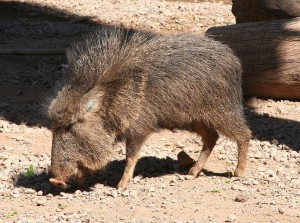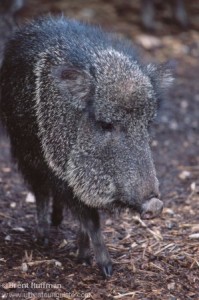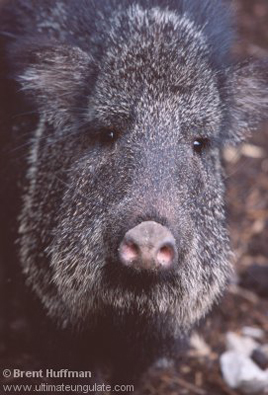
Guest blog by Micaela Camino (Chacoan peccary Fellow)
I have been working in the forests for so many years now, that it is hard for me to imagine what the daily activities of other people are like. I do not really have a routine. Sometimes I am at home analysing information I collected in the forests about the Chacoan peccary and its habitats, other times I go to meetings with politicians or with other groups to explain the importance of this species. My favourite days of the year are the days I find the tracks of the Chacoan peccaries. Luckily, there are a lot of these days.
On the days when I go out to collect data, I wake up really early, have a good breakfast, grab my backpack and leave. It’s not a long commute – as soon as I’m out the door I’m in the forest, but I have to walk to reach deeper into the forest where the peccaries are found.
Then I start walking, really slow, watching the ground and looking about. Chacoan peccaries are like spirits – they’re so hard to see, let alone find. They can be anywhere, they can be right in front of you. The forest has lots of shrubs and there is not much light, so even with a big animal next to you, you may miss them. Walking slowly, concentrating on the sounds, smells and sights in the forest is the only way to find the elusive creature in this huge environment.

When I began working in the Chaco region in 2010, I spent a lot of time with researchers, hunters and ex-hunters, learning how to read the ground. The ground can tell you everything – who was there, when, what he, she or it was doing. You find tracks of armadillos or giant anteaters, see that a puma chased a collared peccary into a patch of dense, thorny shrubs. If you’re lucky, you can see the tracks or bones of Chacoan peccaries, and even find evidence of where one has chewed a cactus. But it’s nearly impossible to actually find one, so we will be placing camera traps soon.
I do not work alone, my team are my friends and family. Many of these people have lived in these forests all their lives, some used to hunt in the forest too, before they discovered that studying this species was more fun. Hugo is an important part of my team – he coordinates activities in the field, carries out surveys and visits schools. Our work would not be possible without him.
Many people ask me why I work with Chacoan peccaries. I have always found large mammals to be attractive species to study. I guess that working with cute, hairy mammals is a dream come true for my inner child! Still, they press me, there are thousands of large mammal species to work with, so why Chacoan peccaries? I always think, why not work with them? They are very mysterious. Although their fossils are known from the Pleistocene (a time period spanning 2.6 million to 11,700 years ago), they were considered long extinct until the 1970’s when they were rediscovered. Even since then there have been very few studies done on them. The studies that have been done show that the species is seriously endangered, genetically unique and has changed very little for thousands of years.

Chacoan peccaries only inhabit the ‘Dry Chaco’ (an area of the Chaco closer to the mountains in the west), which is very dry and sparsely vegetated. This region is very inhospitable – its Spanish its name literally means ‘impenetrable’. Despite the lack of food and water, this is the only place Chacoan peccaries live.
My team and I want to find out more about this cryptic species. Where exactly do they live? What conditions do they need to survive? How do they survive in this harsh environment? We know that Chacoan peccaries are herbivorous, and that they eat fruits, roots and cacti. If you happen to find a recently dead individual, you can check its tongue and see the cacti spines.
The overall aim of the project is the long-term persistence of the Chacoan peccary and its habitat. This habitat is also occupied by the Criollos and Wichís people – local and indigenous people who have a close relationship with their natural environment, who also hunt this species. Hunting is the greatest threat to this species, although habitat destruction is also a major threat. Native vegetation is being replaced by grass to provide pasture for cattle within the Gran Chaco which reduces the amount of food available and leaves the animals with no shelter from predators.
We are working towards developing grass-roots conservation actions for this species, involving local people in this conservation initiative so that their opinions and perceptions are considered as part of the project. In order to do this we will need to disseminate information about the Chacoan peccary and its habitats, and work with local people to develop conservation strategies that are sustainable in the long term.
In the future, we will also need to evaluate different monitoring techniques for the species, including a locally based and managed monitoring system. By the end of the project we hope to therefore have a functioning monitoring system for the species, and a well-developed and evaluated method for studying this unique species.
To help conserve this remarkable and overlooked species, please become an EDGE Champion or donate here.
